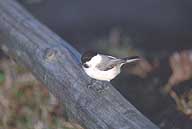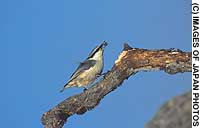Adapting to living when the mercury falls
By Mark Brazil | Jan 17, 2002
BIRD'S-EYE VIEWWhile you were tucking into roast feathered dinosaur (turkey) with all the trimmings this Christmas past, I hope you spared a thought for how other avians make it through the winter. While we humans celebrate in various ways to dispel the gloom of midwinter from the encapsulated warmth of our homes, think of how other species manage.
I always envy those mammals, such as our chipmunks and dormice, which are able to lower their metabolic rate and spend four or five months sleeping. Do they feel refreshed when they wake up in the spring?
I also wonder about species such as the deer and macaques that grow thicker, heavier coats. Having a nice warm coat is one thing, but having to wear it day in and day out seems a trial to me — remember you can’t take it off on sun-warmed winter days, nor can you put on an extra layer when the temperature dips savagely.
Once you have grown it, you are stuck with it until spring. Mind you, that is in fact what many of my human students seem to do — wear the same thick layers of clothes indoors and out, come snow or shine, regardless of the ambient temperature.
Birds, those feathered reptiles, may actually have a better deal than the mammals. Imagine yourself wearing an adjustable down jacket. On really cold days you can pull a toggle and the feathers all align themselves, standing out further, trapping more air, helping you stay warmer. On warmer days you can toggle the other way, sleeking down the feathers in your jacket, thinning it out and reducing the insulation capacity — not bad, especially given that for our avian friends this is just a matter of skin control. Perhaps it is better to be a bird than a hibernating mammal after all.
Of course the human version would have a wind-stopper shell, whereas birds have to avoid the chilling effect of wind in other ways.
Avian adaptations are remarkable. Around 200 million years ago, avian ancestors set off down an irreversible track toward bird-dom. In that process, their forelimbs became ever more adapted for flight, while their value for grasping and manipulating steadily reduced to zero (with the exception of the South American hoatzin that is).
As a result, modern birds are, essentially, handless. Instead, they use their beaks for grasping, gripping, moving, and adjusting, for attacking and feeding, for preening and poking. That is a tremendous range of behaviours they must achieve with one structure — no wonder then that it is possible to recognize the lifestyles of many species by the shapes and adaptations of their beaks.
During this season, with the leaves off deciduous trees, the atmosphere dry and cold, the hard dry “machine-gun rattle” of foraging woodpeckers is a common sound in the wintry woods. For them, their beaks are wood-hewing chisels and bark-lifting levers, and their astonishingly elongated tongues are barbed weapons to impale insect larvae and drag them from their hiding places in the wood.
Other rattles, cracks and rat-a-tat hacks can be heard from the woods in this season, and if they are not coming from woodpeckers there is a very good chance they are coming from one of two other species.
The orangey-chestnut varied tit is a specialist feeder on the small (and not so small) acorns of the various oaks in Japan. These require considerable exertion to hack into, and the sound commonly carries far.
The other producer of the tapping, snapping sounds is the lively nuthatch. This bandit-masked pale-blue woodland denizen is a seed-and-nut specialist during winter (during summer, like many other species, it switches to the abundant caterpillars available in deciduous forests).
Distinguishing nuthatches from other small woodland species, apart from their piratical facial markings, is their agility in running up and down the trunks and major limbs of trees. Their searching eyes seek out any insect prey hiding in crevices in the bark, and also zoom in on seeds.
One reason why this species has increased in number in some areas is the habit we humans have of putting food out for birds. Nuthatches love sunflower seeds. Sunflowers are not a natural food for them, but they just can’t pass up these oil-laden capsules, and they scurry and fight at feeders to obtain a supply.
Watch a nuthatch in action and you will see them arrive at a feeder and dash away again almost instantly. Whereas other species may stick around and consume their food on the spot, the nuthatch is off in search of a suitable anvil. Where a branch meets a trunk, where there is a major crevice in the bark, or where a rotting limb has left a small hole, these are all places favored by nuthatches.
The seed that they have carried away they will wedge into such a crevice and then with whacks and hacks that involve lifting the whole body and hammering using the body, neck and head like a handle wielding the hatchet beak, the nuthatch will hack its way into the seed.
The nuthatch is an easy species to attract to feeders, especially near parks and woodlands, and as the availability of winter food is a limiting factor for the populations of this and many other resident small birds, winter feeding can actually help their populations increase.
But what we give with one hand we so often take away with the other. Our bird table supplies may help them through the harsh periods of winter, but our chemical pollution is doing them in, in other ways. Sometimes the links in nature are just so astonishing as to stop you in your tracks. Our burning of fossil fuels unleashes nitrogen oxide and sulphur dioxide, the raw materials of one of our most serious forms of environmental degradation — acid precipitation.
Acidified lakes and rivers support fewer insects, fewer fish, and hence fewer insect- or fish-eating species. But how could acid rain possibly affect woodland bird populations? Well, research in Europe has shown that in areas with poor soils, acidification of those soils, resulting from acid rain, impairs the uptake of calcium by trees.
That is still a far cry from affecting birds, you might think. However, the large populations of caterpillars that feed on tree leaves during summer are a vital food source for woodland birds, such as the nuthatch, during the breeding season. With less calcium in the trees, the caterpillars take up less calcium when feeding on leaves, and as a consequence the birds take in less calcium from their caterpillar diet.
And what do the birds need that calcium for? Well, during the breeding season one of their main uses for it is in building their eggshells.
In the Netherlands, detailed research has shown that there is direct damage to breeding populations of small woodland birds, including the nuthatch, as a consequence of acid rain affecting woodlands and causing eggshell thinning.
Thinner-shelled eggs are less likely to hatch, and thus the overall populations of birds in those habitats are affected. Sadly then, even though we may protect woodlands in nature reserves, acidification of soils caused by pollution can directly affect trees, insects, and bird populations.


